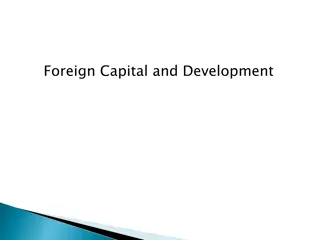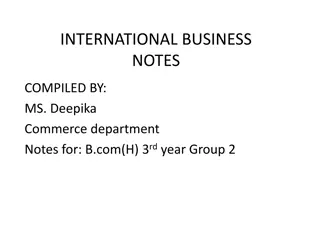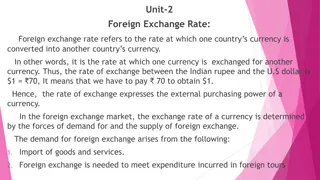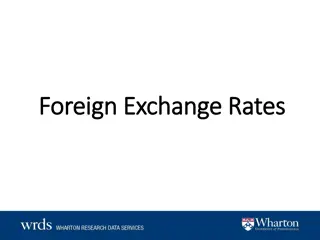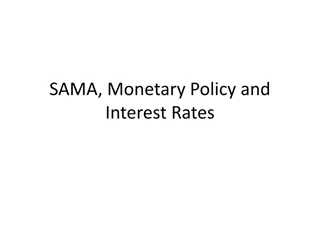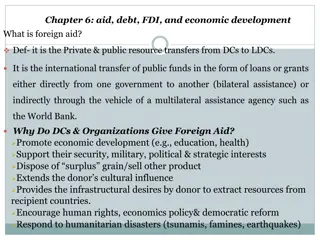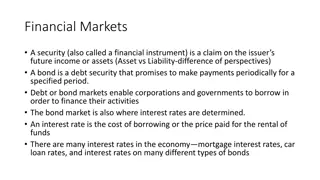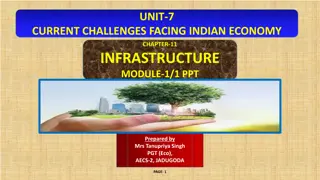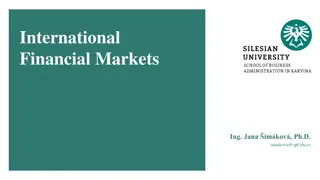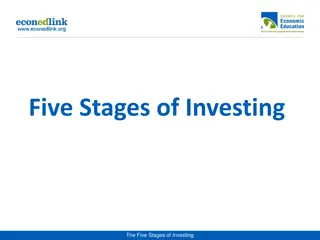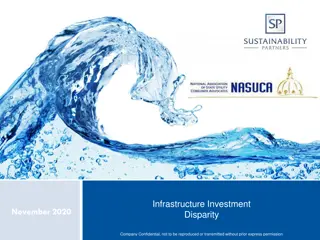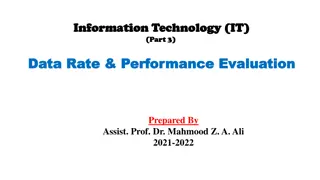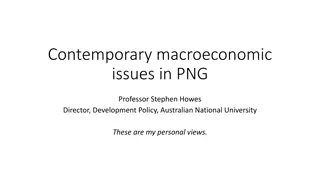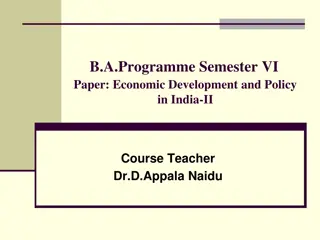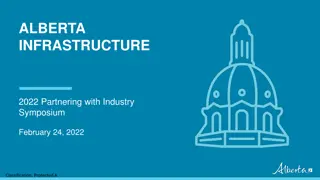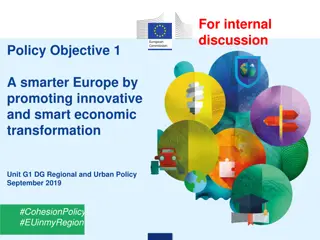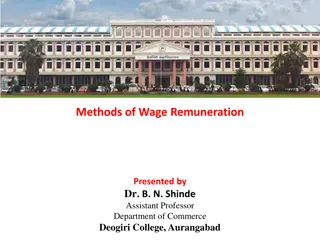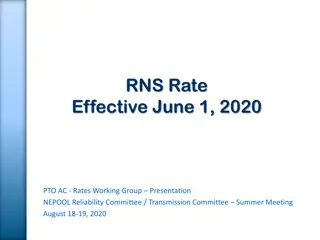Managing Foreign Exchange Rate Risk in Infrastructure Investments: Case Studies
Explore how CELSE tackled foreign exchange rate risk in its LNG power plant project in Brazil through innovative financing strategies involving local debentures, project bonds, and international investors. The project was a joint venture between Golar Power and EBrasil, with significant involvement from IFC, IDB, and other key stakeholders in the infrastructure sector. The case study sheds light on the complexities of cross-border financing in the backdrop of economic challenges and the need for effective risk management in large-scale projects.
Download Presentation

Please find below an Image/Link to download the presentation.
The content on the website is provided AS IS for your information and personal use only. It may not be sold, licensed, or shared on other websites without obtaining consent from the author. Download presentation by click this link. If you encounter any issues during the download, it is possible that the publisher has removed the file from their server.
E N D
Presentation Transcript
Machado Meyer Global Infrastructure Hub Foreign Exchange Rate Risk for Infrastructure Investments: Case-Studies May 19th 2020
Disclaimer: The findings, interpretations, and conclusions expressed in this report do not necessarily reflect the views of the Brazilian Ministry of Economy. The Brazilian Ministry of Economy does not guarantee the accuracy of the data included in this work.
CELSE 1.5 MW LNG Powerplant (integrated to FSRU and dedicated port facility, gas pipeline and transmission line) Brazil Problem Innovation Context CELSE entered into local currency long term loans with the IFC and IDB, for 1/3 of funding needs, and local currency capital market financing for the remaining 2/3 of funds, through tax exempted infrastructure local debentures Celse sold its power through 25-year PPAs under an A-5 2015 Auction in the regulated market in Brazil. Except for the portion of the PPA price intended to remunerate the fuel consumption, the remaining portion of the PPA price is denominated in Brazilian currency and indexed to local inflation CELSE Centrais El tricas de Sergipe S.A., is a joint venture between Golar Power (Norwegian/English capital) and Ebrasil (local player). At the time it successfully commenced its operations, in March 2020, it was the largest LNG powerplant in Brazil. The integrated project also involved the need of constructing a dedicated 33 km transmission line, a dedicated gas pipeline connecting the plant to an FSRU, and the port terminal required to anchor the FSRU. It raised BRL 5.4 billion in financing in 2018 1 CELSE LNG PowerPlant (integrated to FSRU and dedicated port facility and transmission lines) Local debentures were 95% guaranteed by SERV. Through the underwriting of Goldman Sachs, the Brazilian currency denominated debentures were fully acquired by an offshore trust who then issued NY law governed project bonds to the international market, backed up and secured by the debentures. International investors had the option of either take on Brazilian currency risk, or to enter into FX hedging instruments Brazil was still recovering from a major economic crisis. Local development bank (BNDES) had reduced its loan capability and was no longer offering subsidized financing. Local capital market had appetite for simpler/ smaller renewable projects, but not for large thermal plants. Cross border financing was needed, but FX risk had to be addressed Innovation Type: Local Currency Cross- border MDB and Bond Project Financing Stakeholders Involved Such project bond structure was the first of its kind in Brazil. Although, IFC and IDB have already entered into a few Brazilian currency loans before, this was the largest Brazilian currency deal at the time Useful Links: CELSE CELSE, and its shareholders Golar Power and EBrasil GE, as the turbine manufacturer (out of Switzerland, thus the Swiss content) and the main EPC Contractor Ocean LNG Limited, a JV between Qatar Petroleum and ExxonMobil, as the LNG long term supplier IFC and IDB invest, as project lenders Goldman Sachs, as the firm underwritter for infrastructure debentures issued by Celse, and which back-up project bonds issued by an offshore trust holding the debentures Pent gono S.A. DTVM, as fiduciary agent for the debentureholders SERV Swiss Export Risk Insurance, the export credit agency of Switzerland, providing a 95% credit guarantee in respect of the debentures, having Credit Suisse A.G. as SERV Policyholder Agent Timeline March and April, 2018 April, 2018 2018-2020 March 2020 Construction and subsequent disbursements Financial Closing of debentures and First Disbursement of IFC and IDB loans Commercial Operation Date Execution of financial documents 2
CELSE 1.5 MW LNG Powerplant (integrated to FSRU and dedicated port facility, gas pipeline and transmission line) Brazil 1 Key lessons learnt Results/Impact CELSE LNG PowerPlant (integrated to FSRU and dedicated port facility and transmission lines) Under appropriate conditions, and properly developed projects, MDBs, ECAs and other international investors may be willing to take on local currency risk CELSE has been successfully constructed and entered commercial operation in March 2020 Efficient LNG plants such as CELSE help to diversify the Brazilian power generation matrix, reducing the dependency of Brazil on hydro sources and mitigating the risk of wind, solar and biomass projects which do not have a stable/ flat generation profile throughout the year or even during the day Innovation Type: Local Currency Cross- border MDB and Bond Project Financing MDBs provided only 1/3 of the funds, but were key to structure the financing in the first place and leave room for a structured capital market solution Although benefiting from low prices of LNG globally, in the long run these thermal projects may shift to locally produced natural gas, including high volumes which are expected to be produced in the pre-salt region Useful Links: CELSE CELSE paved the way for other large LNG thermal projects, such as GNA 1, GNA 2 and others to come Despite the successful financing and implementation of the project, the innovative and multisourced financing required a long structuring and negotiation process 3
Line 4 (yellow) of So Paulo Subway Context Problem Innovation Executed on November 29, 2006, Line 4 was the first PPP (public private-partnership) in Brazil, in a strict sense, i.e, governed by Law 11,079 of 2004 and thus relying on some level of financial contribution of the Granting Authority (the State of S o Paulo), as opposed to the more traditional common concessions (relying solely on tariffs from end-users) Direct payments from the State of S o Paulo and tariff revenues are denominated in Brazilian currency and indexed to local inflation To mitigate FX risk arising from mismatch between debt service on IDB financing and local currency revenues of the project, a relevant portion of such FX risk is objectively allocated to the Granting Authority Brazil 2 Nevertheless, debt service on IDB financing was denominated in US dollars. IDB finance to the concessionaire consisted originally of a USD 128.9 million A-loan, combined with a USD 213.2 million B-loan Objective risk allocation was an innovation of the then new PPP legislation. Such objective allocation is automatic and does not require a long and less predictable contractual revision process which would necessarily result from the traditional economic equilibrium rebalancing doctrine Line 4 of S o Paulo Subway Such PPP was based on the sponsored modality, pursuant to which the concessionaire is entitled to direct payments from the government, complementing revenues derived from tariff collected from end-users Innovation Type: FX Risk partially and objectively allocated to Granting Authority, under the relevant Concession Agreement At that time, as the first PPP project and the first private concession of a subway line in Brazil, local sources of financing were not available at an affordable cost. IDB had international experience on financing other subway lines, had already helped the State of S o Paulo on prior phases of the project and was committed to support the PPP Section 12.3.1 of the Concession Agreement expressly attributes to the Granting Authority the risk of variations in the foreign exchange rate of the Brazilian Reais against the US Dollar, which may cause an impact in the payment of foreign currency debt , within the limits and conditions set forth in the Agreement. The FX Impact must be demonstrated by the presentation of an opinion of a qualified auditor. The agreement also provides for additional conditions for the recognition of the Concessionaire right to claim for the rebalancing of the agreement With a stated value of BRL 790 million at the time of its execution, and an original term of 30 years, it was also one of the first private concession of subway lines in Brazil (*). Concessionaire was responsible for providing the rolling stock, relevant systems, and the operation of the line. State of S o Paulo remained responsible for the excavation and construction works Useful Links: ViaQuatro IDB Info Timeline May 2008 May 2010 Stakeholders Involved November 2006 May 2004 December 2004 CCR, the controlling shareholder of Via Quatro, the concessionaire of Line 4. State of S o Paulo, as the Granting Authority Companhia do Metr de S o Paulo, the state-owned company of the State of S o Paulo responsible for the operation of the other lines in the S o Paulo subway system IDB, as the main lender for the project, on an A-B Loan structure Commercial operation of the first segment: Faria Lima - Paulista Enactment of the S o Paulo State PPP Law Execution of the PPP Contract Enactment of the Federal PPP Law Approval of IDB financing (*) Metr Rio was, in 1998, the first private concession of a subway line in Brazil. 4
Line 4 (yellow) of So Paulo Subway Brazil Results/Impact 2 Key lessons learnt Line 4 is currently operating through 10 stations, from Luz to S o Paulo-Morumbi, being one of the most important lines in the Sao Paulo subway system. It is expected to be fully completed in the near future, when it will achieve a 12.8 km of extension Line 4 of S o Paulo Subway As a general rule, financing and FX risks are to be handled by the private concessionaire. Nevertheless, in projects that are highly strategic for the Government or population; are very innovative; which present relevant social and economic externalities, and/or where local sources of financing are not available at affordable costs, partial allocation of FX risk to the Government may be justified Innovation Type: FX Risk partially and objectively allocated to Granting Authority, under the relevant Concession Agreement As the first PPP in Brazil, it paved the way for many other PPPs under Law 11,079 regime It also offered a more suitable structure for the private concession of other subway lines (as well as urban trains) in Brazil The generic right to rebalance the agreement to restore its economic equilibrium in many cases will not offer sufficient mitigation to FX risk so as to attract foreign lenders and investors (as such right, in most cases, will not offer sufficient predictability in terms of actual monetary compensation and time to complete such contractual revision) Useful Links: ViaQuatro IDB Info The objective FX risk allocation was only one of its innovations. The PPP also innovated in many other aspects, such as on its guarantee scheme (to secure the revenues payable to the concessionaire), centralized tariff collection on a clearing house responsible for the sharing of the revenues among Line 4 concessionaire, the Companhia do Metr de SP and other operators etc. MDBs and foreign lenders may not only offer more affordable costs, in times of local funding scarcity, but they may also be more prepared to take risks in innovative projects In a large metropolis as Sao Paulo, the expansion of the subway system offers huge social and economic externalities 5
So Paulo State PIPA Toll Road (Piracicaba Panorama Segment) Innovation Context Problem The concession was awarded to the bidder who offered the highest premium over the minimum fixed amount of the signing bonus (valor de outorga). On the other hand, the concessionaire must also pay a variable signing bonus, consisting of 7% over the gross revenues of the concession, throughout the concession term Brazil The State of S o Paulo has one of the most successful program for the concession of toll roads in Brazil As the largest toll road concession in Brazil and part of a round involving other important road concessions in the State of S o Paulo, without prejudice to toll roads also being offered to the market by the Federal Government and other states, there was doubt as to whether there would be sufficient local sources of project financing to meet the huge funding needs of the Pipa Toll Road Project 3 As part of the 4th round of concessions, PIPA Toll Road is the largest road under concession in Brazil, with 1273km S o Paulo State PIPA Toll Road If so elected by the concessionaire at the commencement of the concession, it would be allowed to have the right to deduct from the variable component of signing bonus instalments allocated to the mechanism (up to 3% of gross revenues) the adverse impact of FX variation in relation to the principal amount of foreign currency indebtedness (but not interests) assumed by the project company up to the limit set forth in the tender documents (USD 500 million of principal amount) and duly evidenced to the granting authority The 30-year contract was signed in 2020. It was awarded to a consortium led by local fund manager Patria, with the participation of GIC, the sovereign fund of Singapore Innovation Type: Contractual risk allocation contemplating the reduction or increase of the signing bonus variable component, payable to Granting Authority in instalments throughout the contractual term, depending on the impacts of FX Fluctuation on the concessionaire indebtedness The State of S o Paulo and ARTESP also wanted to increase competition, and attract potential investors beyond the consolidated players Such consortium offered a premium of 7,209% over the minimum bid, i.e., a signing bonus of BRL 1.1 billion. Total required investment is estimated in BRL 14 billion The mechanism works both ways, though. Upon such election, the concessionaire may also be obliged to pay an additional amount of variable signing bonus, up to a total limit of 6% (3% + 3%), corresponding to any gains arising out of such FX variation in connection with the principal amount of its indebtedness (i.e., in case of appreciation of the Real) Stakeholders Involved Timeline State of S o Paulo, as the Granting Authority ARTESP, the state regulatory agency in charge of transportation projects P tria, the local fund manager responsible for the largest infrastructure funds in Brazil, as the leader of the winning bidder consortium and, thus, the main shareholder of the concessionaire SPV GIC, the Singaporean Sovereign fund, holding a relevant participation in the SPV BNDES, has already approved financing for part of the debt required for the project (BRL 3 billion) Useful Links: Parcerias SP January 2020 May 2020 January 2021 October 2019 BNDES approves BRL 3 billion financing covering approximately 58% of funding needs Tender documents are officially released Opening of the Bids (Auction) at B3 Execution of the Concession Agreement 6
So Paulo State PIPA Toll Road (Piracicaba Panorama Segment) Results/Impact Brazil The concessionaire of PIPA Toll Road has not yet elected to trigger the FX mitigation mechanism. It has two years from the date it commenced to operate the road and so far it has only announced a local financing from BNDES 3 Key lessons learnt S o Paulo State PIPA Toll Road However, even if the election is not made, the mechanism was very well received by the market and seems to have contributed to a strong competition for the concession (which resulted in a 7,209% premium over the minimum bid) Contractual mechanisms may offer relevant mitigation to FX and other risks, without necessarily impacting governmental budget Innovation Type: Contractual risk allocation contemplating the reduction or increase of the signing bonus variable component, payable to Granting Authority in instalments throughout the contractual term, depending on the impacts of FX Fluctuation on the concessionaire indebtedness At a minimum, it serves as an insurance for the private investor. If BNDES had not approved the financing, cross- border financing might be a necessity Even when not absolutely necessary, proper FX risk mitigation may increase competition, bring new investors to the table and result in better bids to the government. As opposed to an open-ended government guarantee, the mechanism is limited to the variable component of the signing bonus and, therefore, cannot cause adverse impacts to governmental budgetary funds (such as general tax collections), nor it qualifies as public debt Innovative mechanisms may be replicated and generate positive effects beyond the project for which they were originally conceived Although offering only partial mitigation, simulation tests show that, in practice, as designed, it would cover most scenarios of FX devaluation Useful Links: Parcerias SP The innovative mechanism was replicated into the federal road concessions, starting with the BR-153 Highway (Tocantins Goias), awarded in April 2021 to the consortium led by Ecorodovias 7
Jacaranda Solar Power (Atlas) Project Innovation Problem Context Following a 2019 law that reinforced the right of companies to freely allocate risks in contracts entered between themselves (the Economic Freedom Law), and a general recognition that certain offtakers (e.g. exporters) may also benefit from US dollar indexation in their long term contracts (as corroborated by several bills of law in that direction), Atlas and its offtaker relied on an interpretation of existing legislation (Section 2, V, of Decree-Law 857/69), to conclude that, on certain conditions, it would be permissible for their PPA to remain denominated and payable in Brazilian currency, but indexed to US dollar FX variation Atlas is an international developer and wanted to access international funding for the project Atlas Renewable Energy is developing the 187MWp Jacarand Solar Project, in the Municipality of Juazeiro, State of Bahia Brazil 4 However, power generation projects in Brazil generate Brazilian currency revenues, usually indexed to local inflation (IPCA) It will count with 450 solar modules and produce sufficient power to meet the nees of a city of 750,000 inhabitants Jacaranda Solar Power (Atlas) Project PPAs to supply power to the captive market, through distribution utilities, must follow standardized terms, set forth by the Government/ regulator (the so-called regulated market), without flexibility for adjustments The project required financing of approximately USD 70 million for its implementation Innovation Type: PPA long term revenues were indexed to US Dollar In the case of Jacarand project, there were several elements of connection to justify the US dollar indexation (project finance all in dollars, foreign sponsor, offtaker an exporter and subsidiary of foreign company etc.) PPAs to large consumers (the free market) may be negotiated between the parties, but the market has traditionally interpreted Brazilian laws as prohibiting foreign currency indexation in contracts between Brazilian parties There are at least 3 bills of law in advance stages of legislative process aiming at, among other purposes, expressly clarifying the possibility of such foreign currency indexation in long term energy or infrastructure related agreements with exporters Useful Links: Project Website IDB Info Stakeholders Involved Timeline Atlas Renewable Energy, the sponsor Jacarand Solar Complex, formed by 4 generation plants called Juazeiro V, VI, VII and VIII BID Invest, acting as project lender, and manager of the Clean Technology Fund and Canadian Climate Fund DNB Bank ASA from Norway, acted as co-lender A Brazilian subsidiary of Down Inc., as the offtaker 2017 June 2020 February 2021 October 2020 Execution of USD 67 million 14.8y Project Financing Execution of 15-year PPP Contract Launching of Altas Renewable Installation of first trackers 8
Jacaranda Solar Power (Atlas) Project Brazil 4 Key lessons learnt Results/Impact Jacaranda Solar Power (Atlas) Project Jacaranda Project is being successfully implemented, full force ahead Foreign currency financing may not only be cheaper than local financing for certain projects and on certain circumstances, but may also offer other benefits, such as non-recourse features, faster deployment, attraction of non- recurrent players more sensitive to local currency risk etc. Atlas has already announced a new and larger project, having Anglo American as its offtaker, adopting a similar structure. Atlas Casablanca, in the State of Minas Gerais, will have total capacity of 330MWp and 800 thousand modules Innovation Type: PPA long term revenues were indexed to US Dollar In many cases, there may be room for innovative approaches without the need of specific changes in law According to press articles, many other investors are also considering to replicate the structure, which may have high attractiveness to foreign lenders Useful Links: Project Website IDB Info Nevertheless, clarity in the law and legal certainty may permit the larger dissemination of good practices and structures that may permit projects in Brazil to access cross- border financing in a cost efficient way 9
RenovAr Program Chubut Norte III y Chubut Norte IV Wind Farm Context Problem Innovation Argentina The program launched in 2015 aims to shift the source of 20% of the energy consumed in Argentina to renewable sources until 2025, by promoting renewable projects necessary to produce 1.2GW per year The Chubut project secured a USD 131 million financing agreement with KfW bank Difficult scenario in terms of foreign investment, due to macro-economic conditions which entail high levels of institutional risk, currency fluctuations, and sovereign debt risk 5 The bankability of the projects within the scope of the RenovAr Program was strengthened by several key features, of which we highlight the following: RenovAr Program Chubut Norte III and Chubut Norte IV Wind Farm PPA tariffs in US dollars, but payable in local currency (ARS) RenovAr was designed to mitigate relevant risks faced by investors in renewable energy projects Compensation triggered by payment default or convertibility restrictions in the form of a put option granted by the Government of Argentina and payable out of a pre-funded liquidity and guarantee fund (FODER) Currency devaluation, international monetary defaults, and strict regulations to deal with FX risk have been common occurrences in Argentina, thus affecting potential investments Innovation Type: Financial structuring - PPA long term revenues indexed to USD Wind farms Chubut Norte III (57.66 MW) and Chubut Norte IV (83 MW) developed in the scope of round 2 of the program came into operation in 2021 with the capacity to annually produce 669,100 MWh of energy supplied to the Argentine Interconnection System (SADI) Optional World Bank guarantees in the event that the above- mentioned compensation is not paid or in the event of inconvertibility or non-transferability State-owned company, CAMMESA, acts as offtaker under PPAs, being therefore responsible for the acquisition of the generated energy and the sale and distribution of the energy to the consumers (in pesos) Useful Links: RenovAr Info Genneia Info IFC Report Stakeholders Involved FODER is responsible for mitigating liquidity and offtaker credit risks by providing guarantees and direct financing for the projects Genneia and Pan American Energy (sponsors) Government of Argentina (granting authority and responsible for the program) Fondo para el Desarrollo de Energias Renovables - FODER (guarantor and financing provider within RenovAr generally) Compa a Administradora del Mercado Mayorista El ctrico CAMMESA (offtaker) World Bank (guarantor) KfW (lender) Timeline February 2021 July 2016 October 2016 August 2017 2015 Chubut Norte III and IV commercial operation RenovAr is launched 10 Round 2 Round 1 Round 1.5
RenovAr Program Chubut Norte III y Chubut Norte IV Wind Farm Argentina 5 Results / Impacts Key lessons learnt RenovAr Program Chubut Norte III and Chubut Norte IV Wind Farm Although the government did not initially want to take on some of the risks, it eventually acknowledged that this was necessary to attract investors and create the positive track record required to advance the program and perhaps improve the overall conditions, reduce the risks allocated to the Government of Argentina at subsequent phases Chubut Norte III and IV, awarded in Round 2 of the RenovAr Program, with 32 wind turbines, already generate 140 MW of power, with a total installed capacity to produce 669,100 MWh of renewable energy per year for SADI Innovation Type: Financial structuring - PPA long term revenues indexed to USD Despite the very adverse macroeconomic environment in Argentina, the Program was able to attract international investors and to make those projects economically viable at an acceptable cost The RenovAr program is still ongoing, on its 4th round of concessions, but macro-economic issues and governmental decisions are lowering the construction rhythm and amending original guidelines. Government s commitment to infrastructure projects is essential to ensure legal security for the market players Useful Links: RenovAr Info Genneia Info IFC Report 11
Road Interconnection Concession: Vial Santiago Valpara so Vi a del Mar, Route 68 Innovation Problem Chile Context As one of the first and most relevant PPPs in Chile, the project financing was structured through a bond issuance with an innovative multilateral wrap model with IDB Direct payments from the Government of Chile and tariff revenues are denominated in Chilean peso and indexed to local inflation The Santiago-Valpara so-Vi a Del Mar toll road project consists of the construction and operation and maintenance of a total of 141.36 km, contemplating 4 tunnels, 16 bridges, 22 interchanges and 14 crossings and additional 19.6 km of rural service streets 6 This was the first cooperation of a multilateral institution with a private monoline insurer. IDB was the guarantor of record before bondholders and Financial Security Assurance (FSA) co-guaranteed the remaining amount, benefitting from IDB s preferred creditor status. The structure is analogous to IDB s A/B loan structure Vial Santiago Valpara so Vi a del Mar, Route 68 At that time (late 90s), structuring and financing of similar projects were especially challenging due to the lack of long-term local funding and lack of long term foreign exchange hedging instruments available With an original term of 25 years, the concession favors the fluid transportation of cargo and passengers and allows easy access to the port of Valpara so and other inner cities, also improving accessibility to Gran Santiago Innovation Type: FX Risk partially and objectively allocated to Granting Authority, under the relevant Concession Agreement The issuance amounted to 11 million Unidades de Fomentos (UF) (USD 300 million equivalent). UF is a Deference unit readjusted to cover inflation In addition, as the Concession System was only gaining initial traction, the project companies and concessionaires expected more governmental activity and support A relevant portion of FX risk was objectively allocated to the Granting Authority through a public insurance available at the time, to compensate the concessionaire for the adverse impact on the debt service of depreciation against the US dollar by more than 10% relative to a rate locked in at the time of the debt placement Useful Links: Project Page IJGlobal Info Stakeholders Involved Timeline Sociedad Concesionaria Rutas del Pac fico S.A., as the concessionaire and its shareholders Vias Chile S.A. and Abertis Autopistas Chile III SPA Government of Chile, the Ministry of Public Works, as the Granting Authority IDB as guarantor FSA as guarantor August 1999 April 2002 May 1998 February 1998 Economic Offers Opening Date Financial Closure Beginning of the Concession Term Decree officially granting the Concession 12
Road Interconnection Concession: Vial Santiago Valpara so Vi a del Mar, Route 68 Chile Results/Impact Key lessons learnt 6 Route 68 Concession is currently operating and has had a significant impact on the way of life for a large portion of the Chileans, since it is the main route responsible for connecting two very populous urban areas of the country: Gran Santiago and Gran Valpara so, constituting the busiest land route in Chile As a general rule, financing and FX risks are to be handled by the private concessionaire. Nevertheless, in projects that are highly strategic for the Government or population, including initial projects under a new program or investment regime, as the present case, partial allocation of FX risk to the Government may be justified Vial Santiago Valpara so Vi a del Mar, Route 68 Innovation Type: FX Risk partially and objectively allocated to Granting Authority, under the relevant Concession Agreement As one of the first PPP in Chile, it paved the way for many other PPPs under Decree No. 900 of 1996, responsible for the regulation of the Concessions System in Chile Despite the successful structure of a public insurance protecting the private entity from the foreign exchange risk and inflation variation, considering the low variation of the Chilean currency over the years, the Government does not currently provide any government support in respect of FX risk, leaving the foreign investors to find in the market the necessary tools to protect their investments and financing The objective FX risk allocation was only one of its innovations. Due to the public insurance available and used at the time, the Government would cover the local currency depreciation against the US dollar by more than 10% and, in the other hand, the concessionaire would pay to the Government if the local currency appreciated by more than 10%. With such structure, the private entity could be ensured that it was protected against the foreign exchange risk upon currency devaluation and against the inflation variation during the term of the Concession Useful Links: Project Page IJGlobal Info In addition to the mitigation of FX risk through the private banking market and usual hedging strategies, it is also legally permitted under Chilean law for companies to enter into short or long-term contracts and transactions denominated or indexed in US dollars or other currencies The success of the concession program of Chile and the economic stability of the country enabled subsequent projects to access cross border financing at attractive rates without the need for Chilean government to assume any FX risk 13
Second Concession Arturo Merino Benitez International Airport (Santiago) Context Innovation Problem Chile The Arturo Benitez International Airport in Santiago is the main air terminal in the country, concentrating the largest movements of both passengers and cargo. In 2013, the Chilean Ministry of Public Works designed a plan to increase airport capacity and make the airport the most modern in South America Structure of a multinational consortium with access to capital and industry experience and expertise, being also responsible for providing amounts in equity upfront Direct payments from the Government of Chile and tariff revenues are denominated in Chilean currency and indexed to local inflation. Certain revenues (duty free and certain international fees) might be correlated to foreign currency 7 2nd Concession Arturo Merino Benitez International Airport (Santiago) Execution of different multisource financing agreements with local and foreign banks, denominated both in US dollars and Chilean pesos to match the concessionaire s income generation. FX mismatch risk was mitigated via derivative agreements As part of the second concession, the project involves the renovation of existing installations with the redesign and extension of the existing terminal and the design, build and finance of a new 175,000m terminal for international flights, doubling the airport's capacity to 30 million passengers by 2030. The term for the second concession is of 20 years Challenge of structuring a new concession for a previous project already granted to the private sector, with the purpose of providing new resources and carrying out necessary expansion works and projects to better serve the final users and also to increase the relevance and importance of the International Airport in Latin America According to the terms of the Concession Agreement, the concessionaire and the State would share the commercial income of the Concession and the airport tariffs from the passengers boarded by 22.44% and 77.56%, respectively Innovation Type: FX Risk partially and objectively allocated to Granting Authority, under the relevant Concession Agreement Stakeholders Involved Sociedad Concesionaria Nuevo Pudahuel S.A. (SCNP), as the Concessionaire, constituted as a joint venture composed of A roports de Paris (45%), VINCI Airports (40%) and Italy s Astaldi (15%). Government of Chile, the Ministry of Public Works, as the Granting Authority Santander Chile, Banco Bice, Banco de Cr dito e Inversiones, Itau Corpbanca, Penta Vida Compa a de Seguros de Vida S.A., Seguros Vida Security Previsi n S.A. (local lenders) Banca IMI, Credit Agricole, Societe Generale, Banco Santander Spain and CaixaBank (foreign lenders) Timeline Useful Links: Project Page InfraPPP Info Concessionaire Annual Report December 2022 October 2015 July 2016 March 2015 Estimated commercial operation Beginning of the Concession Term Financial Closing Concession was awarded 14
Second Concession Arturo Merino Benitez International Airport (Santiago) Chile 7 Key lessons learnt Results/Impact 2nd Concession Arturo Merino Benitez International Airport (Santiago) Considering that Chile has been successful in maintaining economic stability, with a very low volatility of its local currency, long term FX hedging is available at feasible costs. Investors are also keener to face on risks that would not be acceptable in other emerging economies In an important country as Chile, the modernization and expansion of its main International Airport offers huge social and economic externalities. The investments planned are aimed at the consolidation of an important hub for pan-Pacific traffic Innovation Type: FX Risk partially and objectively allocated to Granting Authority, under the relevant Concession Agreement Expansion works are currently in progress Due to favorable macroeconomic conditions, private entities in projects structured in Chile usually mitigate their FX risks through the private banking market. In this specific case, the concessionaire entered into derivatives agreements in order to protect itself from FX risk and from variable interest and inflation variation Useful Links: Project Page InfraPPP Info Concessionaire Annual Report 15
Pacfico 3 Toll Road 4G Innovation Context Problem 4 Generation PPPs resulted from an improved legal framework, starting with the creation of ANI, the National Infrastructure Agency Colombia The project includes the improvement and construction of 146km of roads as well as tunnels, bridges and viaducts, to connect the regions of Antioquia, Caldas, and Risaralda. Following construction, the project will be operated by the concessionaire for 25 years Prior private investment initiatives had not accomplished great results in Colombia due to inefficient institutional framework, risk allocation and contractual structure 8 Under 4G PPPs, risk is shared between public and private parties. Once defined functional units of a toll road are completed, concessionaire shall be remunerated by a combination of tolls and payments by ANI (part of which may be indexed to US dollars), including payments to mitigate risks of construction and demand The Government had limited financial resources for the investments needed and, thus, Colombia had to rely on private investment Pac fico 3 Toll Road 4G The Project is part of the first wave of Colombia s National Infrastructure Agency 4G (Fourth Generation) program under PPP scheme, which aimed to build or expand 8,000 km of roads In case of early termination, concession agreement secures indemnity payment sufficient to pay outstanding debt Innovation Type: Improved PPP Framework, Project financing Issuance of bonds internationally and FDN credit enhancement Due to the limited capacity of local investors, the 4G Program had to be attractive for foreign investments as well The financing structure used in this project (total of approximately USD 650 million) included a USD 260 million 144A/Reg S note, which was the first overseas bond for a Colombian toll road An increased sector-concentration and emerging regulations restricted commercial banks capabilities to provide the financing for infrastructure projects The complete multi-tranche, dual-currency, hybrid financing package includes three separate loan tranches along with a credit enhancement facility provided by Financiera de Desarrolo Nacional (FDN), a Colombian state-owned economic development bank Stakeholders Involved Useful Links: GIHub Info FDN - Financiera de Desarrolo Nacional S.A. (state-owned development bank, lender) ANI National Infrastructure Agency (Granting Authority) Conexi n Pacifico Tres S.A.S. (concessionaire) MHC Constructora, Meco, El Condor (as shareholders/ sponsors) Goldman Sachs (book runner for bonds) Bonds&Loans Case Study The introduction of the FDN was one of the main institutional innovations. FDN grants subordinated loans and liquidity guarantees, and at the same time may finance the structuration of projects and advice regional governmental entities Timeline September 2014 February 2016 Apr 2020 Although revenues of the project were in local currency, based on the overall structure, risk sharing and credit enhancement of FDN, foreign investors buying USD denominated notes were willing to absorb FX risk Completion of Tesalia Tunnel drive Date of financial closing Concession was awarded 16
Pacfico 3 Toll Road 4G Colombia Key lessons learnt 8 Results/Impact Constraints in domestic infrastructure investment capabilities may be mitigated by issuing bonds in overseas capital markets. To the extent that projects may secure to index a portion of their revenues into hard currency, project bonds issued abroad may be denominated in such hard currency (at least in the same proportion of foreign currency indexed revenues) Pac fico 3 Toll Road 4G The financing raised enabled a relevant improvement in the road, including two tunnels and several bridges Innovation Type: Improved PPP Framework, Project financing Issuance of bonds internationally and FDN credit enhancement The Conexi n Pacifico 3 Highway was the first project in Colombia's 4G program to reach financial closing. It paved the way for other successful projects under the 4G Program Improvements to PPP frameworks, risk sharing and credit enhancement mechanisms to mitigate investor risks can increase appeal of PPP solutions for foreign investors Approximately 3,000 direct and indirect jobs were created by the project and its associated spillover effects The government increased its support for private sector participation in infrastructure development, improving the country s PPP framework and providing incentives for investors Useful Links: GIHub Info Bonds&Loans Case Study Opportunities may exist to mobilize untapped domestic institutional investors as well, such as pension funds by issuing bonds tailored to their needs (e.g., long tenor and inflation indexation) 17
Bogota Line 1 PPP Project Innovation Problem Context Empresa Metro de Bogota awarded a single concession for the construction of civil works, rolling stock and railway systems, as well as its partial financing, operation and long-term maintenance Colombia The project seeks to improve access to jobs and quality transit for public transport users in the area of influence of the Metro Line The Project is too big for a private concessionaire to finance its full construction cost, but Government of Colombia needs an experienced private concessionaire to undertake overall construction, operation and maintenance with required efficiency 9 The Concessionaire was responsible for financing only USD 1.1 billion out of total project costs. The difference will be financed by EMB itself and then paid to the concessionaire throughout the construction phase (a portion of which in US dollars) It will stretch over 24km, and include the construction of 15 stations and acquisition of 23 trains each able to carry 1,800 passengers, with a maximum capacity of 72,000 passengers per hour Bogota Line 1 PPP Project The Colombian Government is providing most of the funding to EMB. Nevertheless, EMB will also resort to project finance from IDB, IBRD and the European Investment Bank (EIB) amounting to around USD 1.7 billion (guaranteed by the Republic of Colombia) Segregation of the project in different concessions could jeopardize the coordinated and integrated development of the project Innovation Type: Combination of public and private financing, and appropriate risk sharing between state owned company and concessionaire Bogota Line 1 PPP Project is the largest infrastructure project ever undertaken in Colombia, with a total construction cost in excess of USD 4.3 billion The multilateral loans are intended to cover initial costs of the project. Given the mismatch between multilateral financing ( in USD) and project revenue (in COP), the parties resorted to hedging mechanisms put in place to prevent Empresa Metro de Bogota from taking devaluation risk. Multilaterals helped borrower to access currency swaps in a more efficient manner Stakeholders Involved More recently, in July 2020, Empresa Metro de Bogota issued COP- denominated bonds on the Colombia stock exchange as part of its finance package for construction phase. The 23-year bonds are guaranteed by the Government and were designed as a new type of local bond, denominated t tulos de pago por ejecuci n China Harbour Engineering Company (sponsor, leader of the APCA Transmimetro Consortium, awarded with the concession) Xian Metro Company (sponsor) Bombardier (subcontractor) European Investment Bank (EIB) Inter-American Development Bank (IDB) International Bank for Reconstruction and Development (IBRD) Government of Colombia Empresa Metro de Bogota (the borrower, a state-owned company in charge of implementing the project and its overall oversight) Timeline Useful Links: IJGlobal Info The Asset Info World Bank Report Bond Issuance Info August 2018 October 2020 July 2020 2028 Expected commercial operation. Loan approval from World Bank, IDB and EIB Beginning of construction Issuance of local bonds 18
Bogota Line 1 PPP Project Colombia 9 Results/Impact Key lessons learnt The combination of financing to a state-owned company and private financing, under a properly designed concession structure, with appropriate risk sharing, made it possible to develop the largest infrastructure project ever in Colombia Bogota Line 1 PPP Project Multilateral financing for initial stages of the project was used as a strategy by Empresa Metro de Bogota to demonstrate the project s efficiency and attract commercial capital and private finance for the remaining stages of implementation thereof Innovation Type: Combination of public and private financing, and appropriate risk sharing between state owned company and concessionaire The multilaterals US dollar funds will be disbursed between 2020-2025 and may result in around USD 300 million being converted into COP annually, reason why the Government of Colombia has asked the multilaterals (IBRD, IBD and EIB) support in managing the cross-currency swap market While large and complex projects may still need governmental funds and public financing, a combination of public and private financing, through appropriate risk sharing between public and private parties, may secure the best of both words, in a true public private partnership This was the first project financed by EIB in Colombia, under its Climate Action and Environment Facility and aimed at promoting climate change mitigation by fostering the use of public transport and helping to reduce pollutant emissions Useful Links: IJGlobal Info The Asset Info World Bank Report Bond Issuance Info Empresa Metro de Bogota intends to use those US dollar based funds to make payments to the Concessionaire which are associated with the acquisition of rolling stock and imported equipment, thus mitigating FX risk for all parties 19
Jegurupadu Combined Cycle Power Plant Context Innovation Problem India The Phase I of the project involves 217 MW of gas-fired combined cycle power plant comprising three gas turbines of 52.8 MW and a steam turbine of 77 MW. It was one of the first power plants developed with private investment FX risk is passed through under the fixed cost component of the PPA tariff. Basically, FX risk was attributed to AP Transco (offtaker) up to the point of remittance of foreign exchange for debt service. FX mitigation was not limited to indebtedness. The PPA provided that the return on equity for the foreign exchange component of total project equity was referenced to exchange risk, shifting further FX risk on to the government Mitigation of (i) FX risk for hard currency denominated financing and (ii) AP Transco risk as entire output is sold to the SOE under the 18-year PPA, which is a key contract for bankability 10 Jegurupadu Project Power generated by the project is entirely sold under a take-or-pay regime to Andhra Pradesh Transmission Corporation (AP Transco), the state-owned utility and offtaker in Andhra Pradesh The Government of India issued a counter-guarantee in September 1996 covering repayment of external commercial borrowings up to USD 77.7 million, effective as of 1997 Innovation Type: Financial Structuring FX risk attributed to offtaker The project also obtained a guarantee from the Andhra Pradesh government in March 1996 backing all of AP Transco s payment obligations under the PPA Financing for the project came primarily from the IFC, the Nordic Investment Bank and a syndicate of Indian commercial banks (total of USD 181 million) Useful Links: Project Info (Country Study) Timeline Stakeholders Involved February 1997 1996 1993 Andhra Pradesh State GVK Power and Infrastructure Ltd (sponsor holding 40% of the project) Asia Infrastructure Fund (25% shareholder) IFC (lender and shareholder with 10%) AP Transco (state-owned utility, offtaker and 2% shareholder) Nordic Investment Bank (lender) Phase I Commercial Operation Financial Closure of Phase I PPA executed 20
Jegurupadu Combined Cycle Power Plant India Key lessons learnt Results/Impact 10 Government of India acting as guarantor for foreign debt was a determinant factor for ensuring the Project s bankability. Project was constructed mainly on balance sheet by the sponsors due to delays in the issuance of the counter guarantee by the Government of India, mainly caused by a resistance from public officials to issue the guarantee while a lot of controversy was taking place around the Dabhol project (a LNG project developed by Enron in the state of Maharashtra). Accordingly, IFC refused to make disbursements until the formal issuance of the counter guarantee GVK pioneered private power development in the Andhra Pradesh State The Jegurupadu Project displays farsighted design features that enhanced operational efficiencies and minimize environmental impact. The plant has consistently operated and obtained high ratings for environmental performance, with emissions below the standards set by the Government and onsite wastewater treatment Jegurupadu Project Innovation Type: Financial Structuring FX risk attributed to offtaker Due to depreciation of the Indian rupee against the US dollar, the capital cost of the project increased. AP Transco, as offtaker and bearer of FX risk, was responsible for approval of the increased capital cost, but it is reported that AO Transco has failed to absorb such risk, imposing a later renegotiation of the terms of the PPA and reducing the margins derived from the project from sponsors Useful Links: Project Info (Country Study) Overall, however, the project provided positive investment outcome (even though not at the expected 16% return), leading the GVK Group (sponsor) to move forward with an expansion of the plant (Phase II). The 228 MW CCPP Phase II commenced operations in 2009 Following generations of projects faced a lower perceived FX risk in India, to that point that this governmental guarantees became much less frequent 21
Jasa Marga Komodo Bonds Context Problem Innovation Indonesia Notwithstanding the growing demand for further investment in infrastructure, SOEs and projects have difficulty to access a broader variety of funding sources, especially from foreign investors, due to the inherent foreign exchange risks Jasa Marga was the first Indonesian company to issue Komodo bonds in the LSE and raised USD 295 million for its expansion plan. This funding source allowed Jasa Marga to access the broadest and deepest possible range of investors globally. The bonds were subscribed by 15% of local investors (Indonesia), 40% Asian investors, 26% US investors and 19% European investors Need to seek alternative sources of funding from foreign investors to meet local demand for financing. Prior to the development of the Komodo Bonds, sponsors have relied in US dollar or other hard currency denominated capital markets. Upon the devaluation of the local currency, however, sponsors struggled to honor their obligations 11 Jasa Marga Komodo Bonds That was the case of Jasa Marga Persero Tb, the state-owned toll road operator in Indonesia which aimed at doubling their operating toll road by 2019. Its expansion plan required the company to look for funding alternatives and the SOE opted to issue rupiah-denominated bonds (also known as Komodo bonds) on the International Securities Market of the London Stock Exchange (LSE) Komodo bonds are denominated and hence traded in rupiah, but investors subscribe in dollars. The issuer then converts these dollar proceeds to rupiah and purchases the dollar equivalent to meet its coupon payments Innovation Type: Financial Structuring - Local Currency Cross- border Bond Project Financing Unlike foreign bonds that are predominantly denominated in US dollar, Komodo bonds are an intriguing alternative of financing because they mitigate foreign exchange currency risk for issuer, and simultaneously shift it to the investors. For investors, Komodo bonds are means to diversify their portfolio Useful Links: Project Page LSE Report on Komodo Bonds Timeline Stakeholders Involved December 2020 December 2017 Jasa Marga Persero Tbk (Issuer) HSBC and Mandiri Securities (joint global co- ordinators). Deutsche Bank and Standard Chartered Bank (joint bookrunners). Final Maturity of Komodo Bonds Issuance of Komodo Bonds 24
Jasa Marga Komodo Bonds Indonesia 11 Results/Impact Key lessons learnt Komodo bonds may be used for future infrastructure financing, given the size of the investor pool and absence of currency risk for the issuer. Demand for Komodo bonds may increase as US interest rates decline investors are also cautious with the country s FX volatility and this concern is reflected in pricing IDR 4 trillion (USD 295 million equivalent) raised in the issuance, with a coupon of 7,5%, 3 year maturity date (demand had in fact reached IDR 15 trillion) Jasa Marga Komodo Bonds Innovation Type: Financial Structuring - Local Currency Cross- border Bond Project Financing Komodo Bonds as a reliable source of financing that may also be explored by other local companies, other than SOEs. SOEs, however, are in a more privileged position, due to their government backing and low liquidity risk Useful Links: Project Page LSE Report on Komodo Bonds Since Komodo bonds have been issued offshore, the additional cross-border withholding tax could present a potential cost hindrance 25
Local currency financing at the sub- national level in Mexico Context Innovation Problem Mexico Mexican sub-national governments faced challenges in obtaining financing due to various market conditions and regulations, such as the requirement that states may borrow exclusively in local currency from local financial institutions and the spread charged by the local financial intermediary (BANOBRAS) over the cost of funds from ultimate lender. The conditions thus resulted in an uncompetitive overall cost Upon use of the well-developed Mexican peso swap market, IBRD was able to efficiently provide Mexican peso financing to the Guanajuato State for investment in the State plan which included projects in the toll road and sanitation sectors Such issues and constraints resulted in a pricing structure for IBRD loans that was unattractive to sub-nationals in Mexico and an inefficient allocation of foreign exchange exposure for the government. Domestic banks were essentially the only sources of debt financing for sub- nationals 12 Local currency financing at the sub-national level in Mexico The transaction was structured as follows: When borrower submits request to withdraw funds, IBRD executes swap transactions with an international financial intermediary An initial exchange of USD into pesos is carried out under the swap transaction The peso amount is disbursed to BANOBRAS, which then services and repays that disbursed amount in pesos Pricing shall depend on the price IBRD gets from the market BANOBRAS then adds its own lending spread and passes the cost to the final beneficiary (the sub-national government) IBRD wanted to create a mechanism to efficiently provide Mexican peso financing to Mexican sub-nationals at a competitive cost and, at the same time, reduce the currency and interest rate risks to BANOBRAS and the guarantor (the Government of Mexico) The financial intermediaries had traditionally hedged FX risk through a foreign exchange trust fund created by the Ministry of Finance, which effectively concentrated all FX risk relating to foreign currency borrowing by sub-nationals in the hands of the federal government Innovation Type: FX risk transferred to the market, reducing the risks to borrower, guarantor and final beneficiary Timeline Useful Links: World Bank Study Project Page World Bank Report Stakeholders Involved June 2004 December 2009 International Bank for Reconstruction and Development (IBRD) (lender) BANOBRAS (state-owned development bank, acting as local financial intermediary/borrower) IBRD Loan Approval Financial closure Sub-national government Guanajuato State (sub-borrower) 26
Local currency financing at the sub- national level in Mexico Mexico Results/Impact Key lessons learnt 12 The combination of financial products allowed the sub- national government to obtain financing at an attractive cost The Mexican peso loan (equivalent to USD 108 million) was intended specifically for the Decentralized Infrastructure Reform and Development Project by the government of the Guanajuato State Local currency financing at the sub-national level in Mexico The project was the first local currency IBRD loan According to the World Bank, a multi-sector swap structure in a single transaction may not be practical because it requires significant effort to design and supervise and an in-depth understanding of each sector, with availability to engage in policy issues within sectors, therefore elevating related costs IBRD s Mexican peso financing resembles a line of credit denominated in US dollars that is disbursed, serviced, and repaid in pesos. The structure transfers foreign currency risk from the borrower to the market. Consequently, the currency and interest rate risks to the borrower, the guarantor, and the final beneficiary are drastically reduced Innovation Type: FX risk transferred to the market, reducing the risks to borrower, guarantor and final beneficiary This was a multi-sector projects since funds were applied by the State of Guanajuato in four project components: (i) component 1 funds the road transport sector strategy; (ii) component 2 finances the water supply and sanitation sector strategy; (iii) component 3 finances the low-income housing sector strategy; and (iv) component 4 finances the technical assistance component for the State Government apparatus, including strengthening the mechanisms to screen, prioritize and monitor public investments, among others The overall strong performance of the governmental agencies indicates that at least some Mexican states have the capacity to successfully implement Bank- financed projects. Infrastructure support to the states is both important and feasible, therefore the World Bank concluded it should continue to pursue the sub-national infrastructure agenda in Mexico, however a new and more efficient structure for delivering such support needed to be formulated Useful Links: World Bank Study Project Page World Bank Report 27
IIRSA Norte Toll Road Innovation Upon completion of certain construction milestones, the project receives CRPAOs Reconocimiento de Derechos del Pago Anual por Obras), which represent irrevocable payment obligation government. The CRPAOs were then used to back up project bonds issued on international markets to raise capital for construction Context Problem Peru (Certificados de Peruvian ambitious plan to rejuvenate 955 km of roads connecting the fluvial port of Yurimaguas with the Pacific port of Paita, aiming at promoting economic growth in remote areas of the country government had an The government faced a shortage of financial resources to meet the cost of the project due to its reliance on the cyclical prices of commodities 13 an unconditional of the and Peruvian IIRSA Norte Toll Road There were no local sources of long term financing available in Peru for larger projects USD 60 million partial credit guarantee from IDB to back the financial obligations of the Government under the concession, including under the CRPAOs (IDB receiving a counter-guarantee from the Government) The project is also part of a wider plan to better integrate networks across South America, in this case between Peru and Brazil infrastructure Innovation Type: Project financing Debt bonds guaranteed by unconditional government payment obligation Thus, the government needed to attract private investment to the country s road network This was the first Peruvian company to raise financing via SEC Rule 144-A bonds, denominated in USD and governed by NY law. Buyers included US and European bondholders Stakeholders Involved The proceeds of the bonds were invested in Morgan Stanley credit-linked notes to create a return on the proceeds until these were construction works leading to additional CRPAOs Useful Links: Construtora Norberto Odebrecht (sponsor) Odebrecht Investimentos em Infraestrutura (sponsor) Grana y Montero (sponsor) Construtora Andrade Gutierrez (sponsor) IIRSA Norte (project company) IDB (guarantor) GIHub IIRSA Norte Tramo LatinFinance IIRSA Norte IJGlobal IIRSA Norte invested in further Timeline August 2005 June 2005 2011 Agreement signed between the parties Financial closure Full length route inauguration 28
IIRSA Norte Toll Road Peru Peru Key lessons learnt 13 X As a general rule, financing and FX risks are to be handled by the private concessionaire. Nevertheless, in projects that are highly strategic for the Government or population, including initial projects under a new program or investment regime, as the present case, partial allocation of FX risk to the Government may be justified Results/Impact IIRSA Norte Toll IIRSA Norte Toll Road Road The government scheduled payments to the project sponsor are ensured irrespective of traffic volumes, thus eliminating the risk that toll-income would fall short of projections. This has caused CRPAO- backed project bonds to have very favorable reception with investors USD 213 million financed through the issuance of SEC Rule 144-A bonds, (certificados de reconocimiento de pago anual de obras) guaranteed by CRPAOs Innovation Type: Project financing - Debt Debt bonds guaranteed by unconditional government payment obligation Innovation Type: Project financing Bonds were denominated in US dollars and governed by New York law, therefore being attractive to international investors and allowing the concessionaire to access a larger pool of capital at better terms Travel time from Yurimaguas to Paita reduced from 36 hours to approximately 18 hours Useful Links: First year of operation of the toll road experimented a traffic increase of 41.5% compared to the previous year The experience with CRPAOs has allowed the Peruvian government to develop and refine the model for existing and future projects, thus shifting to a similar RPI-CAO1 (Remuneration for Investments Certificate of Progress of Works) financing structure GIHub IIRSA Norte Tramo LatinFinance IIRSA Norte IJGlobal IIRSA Norte GIHub IIRSA Norte Tramo LatinFinance IIRSA Norte IJGlobal IIRSA Norte Useful Links: The Peruvian government has not missed a single payment so far, building confidence in other CRPAO schemes (or their successors) The RPI-CAOs are not materialized in certificates and have been designed as irrevocable but contingent obligations: Government is only obliged to make payments to the concessionaire to the extent that project revenues toll below a guarantee level (top up obligations) 29
Rustenburg Water Services Trust (RWST) Innovation Context Problem South Africa First application of project finance structure in the water sector in South Africa. The financing was in local currency (ZAR), which itself was used as a mechanism to mitigate any currency risks associated with the project Expansion of mining operations in the Rustenburg region in South Africa eventually led to strong population growth and shortened the treated water capacity and availability which had long been constrained A lack of sufficient available governmental funding for improvement of the local water infrastructure 14 Private, commercial and public financing under a special purpose vehicle (the RWST) for improvement of the Rustenburg water and wastewater infrastructure. The establishment of a Trust, with revenues ring-fenced from the municipality and strong operating arrangements, provided comfort to the lenders. Public funds were used mainly to help structure the transaction Insufficient water capacity and balance Rustenburg Water Services Trust PPP The inefficiency and lack of capacity of the sewage treatment works in the region led to pollution of the Bospoort Dam Innovation Type: Water efficiency solutions, creditworthy vehicle and strong revenue stream Use of non-potable treated sewage for industrial purposes with long-term offtake agreements with local mines, thus creating a strong revenue stream Stakeholders Involved Rustenburg Municipality was the sole beneficiary of the RWST, thus avoiding political issues typically faced in PPPs Useful Links: World Bank Group Water Scarcity Solutions Case Study Publication Useful Links: World Bank Group Water Scarcity Solutions Case Study Publication ABSA Bank (local commercial bank, lender) Development Bank of Southern Africa (in collaboration with ABSA) (lender) Rustenburg Local Municipality (granting authority and also provided public funds for the project s development) Anglo Plat and Impala Plat (major platinum mines acting as offtaker by purchasing the non- potable wastewater produced) Timeline December 2003 January 2004 2003 Presentation of the Request for Proposal Financial closure Construction works 30
Rustenburg Water Services Trust (RWST) South Africa 14 Key lessons learnt Results/Impact Rustenburg Water Services Trust PPP Possibility of replication of this investment model, in which private investors may secure a predictable long term stream of revenues through long term offtake agreements (in this case, for the supply of water for industrial purposes), especially in areas with strong industrial activity The offtake agreement with local Platinum mines secured 50% of the project s revenue streams Limited recourse loan from ABSA to finance the water and wastewater infrastructure upgrades and expansion, with a 20-year term, worth ZAR 280 million (equivalent to USD 37 million) Innovation Type: Water efficiency solutions, creditworthy vehicle and strong revenue stream Private financing in joint efforts with public sectors/ authorities is key to fund-raising and carrying out important infrastructure projects, even in less economically relevant municipalities Establishment of a sustainable bulk water and sewage system with cash reserves worth USD 12 million after 7 years of operation Useful Links: World Bank Group Water Scarcity Solutions Case Study Publication Useful Links: World Bank Group Water Scarcity Solutions Case Study Publication Increase of available potable water and imported freshwater used for domestic purposes by the Rustenburg Municipality Creation of the ring-fenced trust led to avoidance and mitigation of political risk to the Project by determining the Municipality as the sole beneficiary of the RWST The Project has been successfully operating since and has met all of its debt commitments and obligations 31
Gautrain Rapid Rail Link PPP Innovation Context Problem The South African Government funded 50% of the development costs of the project and the remainder of the costs were funded through, among others, provincial borrowings, private sector equity and private sector borrowings (including IFC, the African Development Bank and commercial banks). South Africa The development of the high-speed 80 km-long rail link project results from local needs in reducing traffic congestion, increasing environmental sustainability and creation of employment opportunities Variable interest and foreign exchange rates 15 28% of development period costs were denominated in foreign currency and hedging costs in connection therewith were high During the development phase, payments by the Government were partially indexed in foreign currency other than for the portion of the private party s costs for which local content was required. For such purposes, in the financial modeling for the project, foreign denominated costs were converted by the granting authority into local currency at a spot rate in 2006. FX rates were then fixed until 2011. The National Treasury acted as a currency swap counterparty to the Gauteng province, eliminating the additional cost for currency hedging. Gautrain Rapid Rail Link PPP The transportation demand relating the 2010 World Cup held in South Africa also contributed to the inception and development of the project National Governmental guidelines provided for denomination of costs in local currency Innovation Type: Financing structure Alternate allocation of FX risk in different project stages The PPP scheme included a 19.5- year contract for the construction, operation and maintenance of the Gautrain Useful Links: Gautrain Management Agency - Case Study IFC Info Gautrain Management Agency 2019/2020 Annual Report Centre for Public Impact Useful Links: Gautrain Management Agency - Case Study IFC Info Gautrain Management Agency 2019/2020 Annual Report Centre for Public Impact During the Operational Period, FX hedging costs were undertaken by the concessionaire. Stakeholders Involved Bombela Concession Company (Pty) Ltd (concessionaire) Gauteng Provincial Government (granting authority, public partner in the PPP) National Treasury and National Treasury Department of Transport (main financiers) Gautrain Management Agency (special agency created to manage, coordinate and oversee the Gautrain Project during the Operational Period) IFC, African Development Bank and commercial banks (lenders) Timeline 2005 2012-2027 2012 2006 Project was approved by the government Necessary federal funding was approved Formal end of construction Operational Period 32
Gautrain Rapid Rail Link PPP South Africa 15 Key lessons learnt Results/Impact Anticipation of future needs and risks relating to the project by preparing a financial model design which accurately indicates allocation of the project s funds is paramount to ensure the success of a project. Gautrain Rapid Rail Link PPP Creation of the first state-of-the-art Rapid Rail Link project in Africa, which contributed to social-economic growth by creating jobs and enabling economic empowerment. Innovation Type: Financing structure Alternate allocation of FX risk in different project stages Private financing in joint efforts with public sectors/authorities was key to obtaining financing and properly mitigating project risks, such as FX risk, which was undertaken both by public and private contracting parties in alternate periods of the project. The definition of clear dispute solution mechanisms was also important to maintain the cooperation and joint efforts between public and private parties. Increase in tourism-related revenues, due to the transportation availability, in the Gauteng Region. The Gautrain has met its main objectives and by 2015 (i) there were nearly 60,000 daily individual journeys and the number of journeys exceeded 1.4 million per month; (ii) it was estimated to have replaced about 21,300 daily car trips, thus reducing their carbon footprint by 52% per trip; and (iii) more than 4,600 local jobs had been created and retained from 2000 to 2015. Useful Links: Gautrain Management Agency - Case Study IFC Info Gautrain Management Agency 2019/2020 Annual Report Centre for Public Impact Useful Links: Gautrain Management Agency - Case Study IFC Info Gautrain Management Agency 2019/2020 Annual Report Centre for Public Impact Projects can benefit from strong political support and commitment from the government. The South African Government, in this case, provided a great part of the funding and acted as an important agent in mitigating key project risks, such as variation in foreign exchange rates. 33
Baakehir am & Sakura City Hospital PPP Project (also known as Ikitelli Integrated Health Campus) Innovation JPY 163 billion (USD 1.5 billion equivalent) loan co- financed by JBIC and other Japanese financial institutions (financing in Japanese currency) Turkey Context Problem kitelli Integrated Health Campus Project is a PPP project designed to serve the European side of Istanbul and intended to serve 60,000 visitors per day The integrated campus required experienced sponsors due its complex construction and operation features 16 JBIC provided political risk guarantee for part of the financing whereas NEXI provided insurance for the remaining part of the financing Revenues are in local currency and include (i) quarterly availability payments from the Ministry of Health; (ii) monthly service payments; and (iii) commercial revenues, which the concessionaire is free to collect Ba sak ehir PPP Project MIGA provided political risk insurance for the Sojitz Corporation subsidiary investing in the project (Sojitz Hospital PPP Investment B.V.) It involved the design, construction, financing and operation of a health campus, with an investment period of 3 years and operation period of 25 years Innovation Type: Financial structuring FX risk mitigated by comparison between FX rate and inflation. In Turkish healthcare PPPs, FX risk is mitigated according to a very complex formula within the PPP agreement. In summary, the formula provides for a comparison between increase in inflation vs. increase in foreign currency Core medical services and staff are provided by the Ministry of Health, but the concessionaire provides maintenance and operation services Therefore, if there is an increase in exchange rate that is higher than the increase in inflation, the difference is reflected in an increase to the availability payment and the opposite is true as well. However, the availability payment shall never be higher than the cap nor lower than the floor (both of which are also determined in the agreement) The project was a cooperation between the Turkish and Japanese governments and private investors Useful Links: Ikitelli SPV Website JBIC Information MIGA Information Sojitz Information Stakeholders Involved Timeline R nesans Healthcare (sponsor) Sojitz Corporation (sponsor) Japanese Bank for International Cooperation (JBIC) (lender) Nippon Export and Investment (NEXI) (insurance provider) World Bank s Multilateral Insurance Guarantee Agency (MIGA) (insurance provider) January 2016 July 2017 May 2020 Agreement signed between the project company and the Ministry of Health Official inauguration Financial closing 34
Baakehir am & Sakura City Hospital PPP Project (also known as Ikitelli Integrated Health Campus) Turkey 16 Results/Impact Key lessons learnt Ba sak ehir PPP Project The project was awarded with Thomson Reuters PPP Deal of the Year and was the first hospital PPP supported by Japanese companies and JBIC The FX mitigation mechanism allows the projects to remain bankable while also providing more long-term sustainability and financial health, which has enabled the government to attract many foreign investors to the country s healthcare PPP sector Innovation Type: Financial structuring FX risk mitigated by comparison between FX rate and inflation. Part of the hospital complex opened early, in April 2020, given the rising number of COVID-19 patients in Istanbul The Turkish Treasury has been closely monitoring the projects and preparing budgetary and financing reports so as to constantly monitor risk exposure stemming from the PPP projects The USD 1.8 billion landmark PPP project is recognized as the world s largest seismically isolated building, with over 2,000 seismic isolators The project has contributed to the progress of the hospital business led by the Turkish government in addition to promoting the participation by Japanese companies in overseas infrastructure business Useful Links: Ikitelli SPV Website JBIC Information MIGA Information Sojitz Information Well structured PPP projects are able to transform a country s healthcare facilities system, thus improving the services available to its population The Project was critical for establishing a large-scale integrated hospital in Istanbul and responding to the increasing demand for medical services as a result of a rising population and economic growth 35
Thank you machadomeyer globalinfrastructurehub


